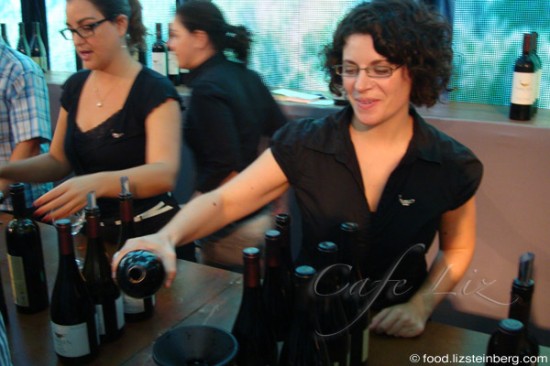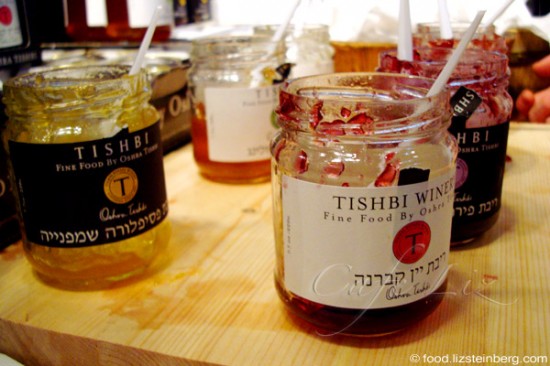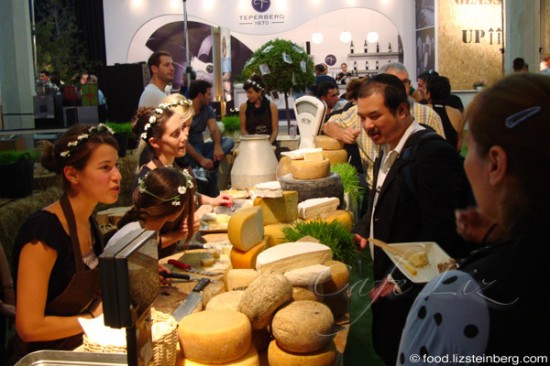Wines (and other things) I liked at the 2010 expo

I had the pleasure of attending Sommelier 2010, Israel’s annual wine expo for industry professionals. Fortunately that includes food bloggers, so Irene, who works as a wine steward for the Golan Heights Winery, recommended that Miriam, Sarah, Yael and I attend. And attend we did, sampling wine for six hours and having quite the blast.
I took about 100 photos while I was there, which I thought would be more than enough to give me a good selection of quality photos for a post. Boy was I wrong. Lo and behold, after about the first 5 or so — meaning the first two samples of wine — they were all blurry. The more we became “wine experts,” as Miriam put it, the worse my photography became. That, and it began getting dark, and I wasn’t set up to take good photos in that lighting.
Since this is the premier event for industry professionals, all the wineries in attendance obviously had their best wines on offer. I’m not sure I tasted a single bad wine. At worst, there might have been a few that I found unremarkable, but that’s by no means an insult.
But despite all the excellent wine we sampled, I’m by no means an expert, and by no means could I give you a proper wine review of everything I sampled. I certainly couldn’t tell you which was my favorite from among the two-dozen plus Merlots we sampled.
Instead, I’ve prepared a list of things that stood out by virtue of being unusual, in a good way. Many of these may not even be on the market yet, since that’s part of the point of the expo.

A few things of note: Israeli wines tend to be alcoholic, because the climate leads to grapes with high sugar content. Israeli wines can easily be 14% alcohol, while European wines tend to be 11% or 12%, Irene explained to us.
Also of note — lots of 2007 wines were on display. Apparently it was a good year, because it was completely normal — no extreme weather in one way or the other, Irene explained. That said, we heard different opinions as to how the 2010 wines would be — whether this year’s extreme summer heat, which led to an earlier grape harvest, would positively or negatively impact wines is apparently up for debate, but the one thing we did hear is that these years’ wines would be different as a result.

Wines:
 Grenada semi-dry pomegranate wine: I didn’t think I liked pomegranate wine, because I’ve always found it to be cloying in the past. Grenada’s semi-dry proves that pomegranate wine isn’t just conceptually interesting, but can also be something that you’d want to drink. This wine indeed tastes like it’s been made from pomegranates, but offers some complexity, too. The winery makes its wine by crushing the pomegranates, and the representative pointed out that it doesn’t have an overwhelming bitterness from the peels, which I guess is a liability in the world of pomegranate wine. The winery, in Gan Hadarom, has been in existence since 2002, and started selling the wine on a wider scale in 2007.
Grenada semi-dry pomegranate wine: I didn’t think I liked pomegranate wine, because I’ve always found it to be cloying in the past. Grenada’s semi-dry proves that pomegranate wine isn’t just conceptually interesting, but can also be something that you’d want to drink. This wine indeed tastes like it’s been made from pomegranates, but offers some complexity, too. The winery makes its wine by crushing the pomegranates, and the representative pointed out that it doesn’t have an overwhelming bitterness from the peels, which I guess is a liability in the world of pomegranate wine. The winery, in Gan Hadarom, has been in existence since 2002, and started selling the wine on a wider scale in 2007.
www.granada.co.il
Tavor 652 red brut: Like Lambrusco, but better. Tavor has been selling the two wines in this series, named for the height of its vineyard, for a few months now. The bubbles are created by fermenting the wines in pressurized barrels, in a process called Charmat, as opposed to in the wine bottles. The red wine is made from Barbera grapes; the other wine in the series is white, from chardonnay/Cabernet Sauvignon grapes. Recommended retail prices are 55-59 shekels. http://www.taborwinery.com/index_eng.html
Golan Heights Yarden Pinot Noir 2007: This was the lightest red wine among the seven or eight wines that Irene presented to us. It’s oaky but light, and apparently many people don’t like it for that reason. I actually enjoyed the lightness. This wine is not on the market yet, and apparently Pinot Noirs are unusual in Israel, because they’re difficult to grow here, Irene explained. The wine will probably retail for at least 80 or 90 shekels.
 Gustavo & Jo. Shani Fume Blanc 2009 : This wine is made from sauvignon blanc grapes from a single vineyard in the Upper Galilee, and it had such strong cherry and apricot flavors that even I tasted them. The winery Gustavo & Jo. is in Kfar Vradim and produces about 5,000 bottles a year; the wine is being distributed by Hakerem. Recommended sales price is 66 shekels. http://www.israelwines.co.il/MiniDefault.aspx?mi=33
Gustavo & Jo. Shani Fume Blanc 2009 : This wine is made from sauvignon blanc grapes from a single vineyard in the Upper Galilee, and it had such strong cherry and apricot flavors that even I tasted them. The winery Gustavo & Jo. is in Kfar Vradim and produces about 5,000 bottles a year; the wine is being distributed by Hakerem. Recommended sales price is 66 shekels. http://www.israelwines.co.il/MiniDefault.aspx?mi=33
Other wines of note: Barkan presented us with a series of three, 2007 Merlots, otherwise identical except for the vineyards from which the grapes came. The wines in the series, named Altitude, were labeled based on the elevation of the vineyard (in meters above sea level), 412, 624 and 720 — a reoccurring trend we saw. The differences in flavor were striking. While this probably comes as no news to your average wine critic, it’s quite interesting to experience especially if you’re not an expert, because it makes the concept of terroir very clear and understandable.

Things that aren’t wine:
Tishbi Cabernet jelly: The Tishbi winery offers a series of about a dozen wine-based jams, half of which feature wine varieties and the other half of which feature wine and fruit combinations. The Cabernet jelly was my favorite because of its strong wine flavor. OK, they all had strong wine flavors, but I guess the Cabernet was what I would want a wine jam to taste like: sweet as your average jam, and without the harshness of tannins. Recommended retail price is 25 shekels.
http://tishbi.com/Store.php?token=cat&cat=5
Olia coffee vinaigrette: Along with at least a dozen kinds of olive oils, Olia also offers a series of balsamic vinaigrette dressings, including a coffee vinaigrette. A fabulously interesting concept, and it also tastes good. Their vinaigrette contains balsamic vinegar, espresso and lemon zest, among other ingredients. The espresso flavor comes as a bit of an afterthought to the vinegar, but it’s definitely there, and I enjoyed the combination. Bottles will be selling for 50 shekels, which is a little steep for those of us accustomed to making our own salad dressings, but this is an interesting product nonetheless. http://www.olia.co.il/index.php
Jacobs Farm roquefort/kechota cheeses: There’s nothing like cheese to offset wine — so much so that one wine buyer said that industry members look askance when wineries present cheese with their wines, because cheese is known to make wine taste better. But hey, I wasn’t complaining. Jacobs Farm had a stand with a dozen-plus types of cheeses, and my favorites were the Roquefort and Kechota goat cheeses. Both were very rich — 30% fat or so — with a prominent but not overpowering flavor.
http://www.gvinot.co.il/product/8281,433,1392.aspx
http://www.gvinot.co.il/product/10318,433,1560.aspx




